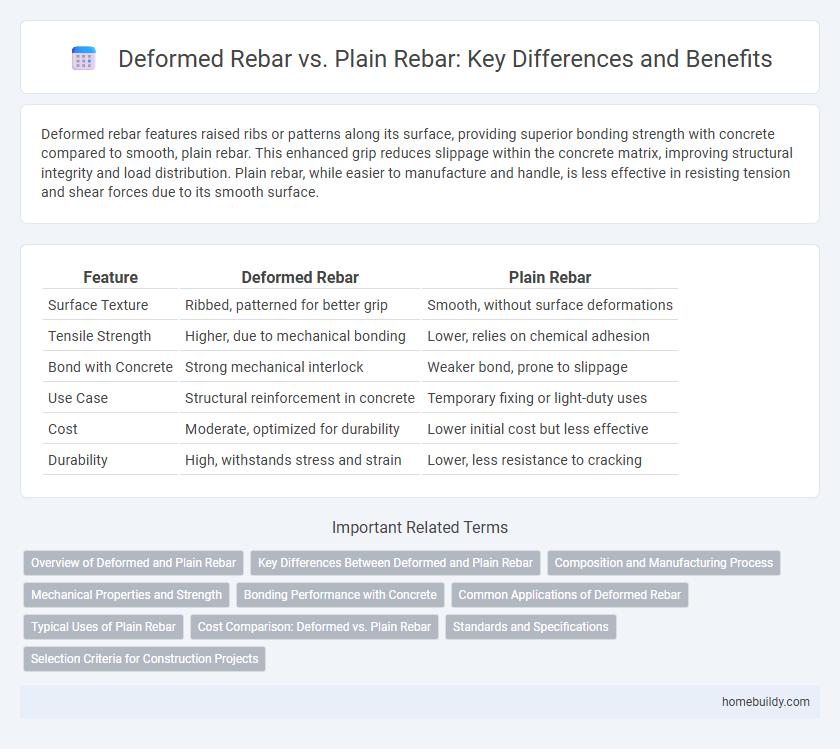Deformed rebar features raised ribs or patterns along its surface, providing superior bonding strength with concrete compared to smooth, plain rebar. This enhanced grip reduces slippage within the concrete matrix, improving structural integrity and load distribution. Plain rebar, while easier to manufacture and handle, is less effective in resisting tension and shear forces due to its smooth surface.
Table of Comparison
| Feature | Deformed Rebar | Plain Rebar |
|---|---|---|
| Surface Texture | Ribbed, patterned for better grip | Smooth, without surface deformations |
| Tensile Strength | Higher, due to mechanical bonding | Lower, relies on chemical adhesion |
| Bond with Concrete | Strong mechanical interlock | Weaker bond, prone to slippage |
| Use Case | Structural reinforcement in concrete | Temporary fixing or light-duty uses |
| Cost | Moderate, optimized for durability | Lower initial cost but less effective |
| Durability | High, withstands stress and strain | Lower, less resistance to cracking |
Overview of Deformed and Plain Rebar
Deformed rebar features surface ribs or indentations that enhance bonding strength with concrete, reducing slippage and improving structural integrity. Plain rebar has a smooth surface, offering less mechanical interlock but used in applications where bending is frequent or bonding is less critical. Understanding these differences is vital for selecting the appropriate reinforcement based on load conditions and construction requirements.
Key Differences Between Deformed and Plain Rebar
Deformed rebar features surface indentations or ribs that enhance bonding with concrete, significantly improving structural strength and load transfer compared to plain rebar, which has a smooth surface. Plain rebar is typically used in applications where minimal bonding is required, while deformed rebar is preferred for reinforced concrete to resist slippage and improve overall durability. The mechanical interlock provided by deformed rebar ribs is a critical factor in seismic and high-stress constructions, ensuring stability and performance under dynamic loads.
Composition and Manufacturing Process
Deformed rebar is made from carbon steel with surface ribs and patterns created during the hot rolling process, enhancing its bond strength with concrete. Plain rebar, typically composed of mild steel, undergoes a simpler rolling process without surface deformities, resulting in a smooth finish. The manufacturing differences affect the rebar's mechanical properties and suitability for various construction applications.
Mechanical Properties and Strength
Deformed rebar exhibits superior mechanical properties compared to plain rebar, primarily due to its surface ribs that enhance bonding with concrete and reduce slippage under stress. Its increased tensile strength and yield strength make deformed rebar ideal for reinforced concrete structures, ensuring better load distribution and durability. Plain rebar, with a smooth surface, offers lower bond strength and is typically used in applications where minimal mechanical stress is expected.
Bonding Performance with Concrete
Deformed rebar features surface ribs or indentations that significantly improve bonding performance with concrete by providing mechanical interlock, preventing slippage under stress. Plain rebar has a smooth surface resulting in weaker adhesion and less effective load transfer between steel and concrete. The enhanced bond strength of deformed rebar makes it the preferred choice in reinforced concrete structures requiring high tensile strength and durability.
Common Applications of Deformed Rebar
Deformed rebar is widely used in reinforced concrete structures such as beams, columns, slabs, and foundations due to its enhanced bonding strength with concrete. Its surface ridges provide superior grip, making it ideal for high-stress construction projects like bridges, highways, and commercial buildings. Plain rebar is generally reserved for lighter applications where bonding requirements are minimal.
Typical Uses of Plain Rebar
Plain rebar is typically used in applications where tensile strength requirements are lower, such as in non-structural concrete elements like sidewalks, masonry walls, and slabs on grade. Its smooth surface provides easier handling and better corrosion resistance in environments where bonding with concrete is less critical. Plain rebar is preferred for reinforcing purposes where adhesion between steel and concrete does not significantly impact performance or safety.
Cost Comparison: Deformed vs. Plain Rebar
Deformed rebar generally costs more than plain rebar due to its manufacturing process and enhanced bonding capabilities with concrete. While plain rebar is cheaper upfront, deformed rebar reduces overall project expenses by providing superior structural integrity and minimizing maintenance costs. The cost effectiveness of deformed rebar makes it the preferred choice in most reinforced concrete applications despite its higher initial price.
Standards and Specifications
Deformed rebar adheres to standards such as ASTM A615 and BS 4449, which specify rib patterns for improved mechanical bonding in concrete structures, while plain rebar conforms to standards like ASTM A82 that define smooth-surfaced reinforcement for limited applications. Deformed rebar specifications emphasize yield strength ranges--commonly Grade 60 or 420 MPa--and rib geometry to enhance grip, whereas plain rebar standards prioritize tensile strength and ductility without surface texturing. Compliance with these standards ensures the appropriate selection of rebar type according to structural requirements and load-bearing specifications.
Selection Criteria for Construction Projects
Selection criteria for construction projects prioritize deformed rebar due to its superior bonding strength and resistance to slippage within concrete, which enhances structural integrity. Plain rebar, lacking surface ribs, is generally chosen for non-structural applications or where minimal tensile reinforcement is required. Project requirements such as load-bearing capacity, environmental exposure, and compliance with building codes heavily influence the choice between deformed and plain rebar.
Deformed Rebar vs Plain Rebar Infographic

 homebuildy.com
homebuildy.com